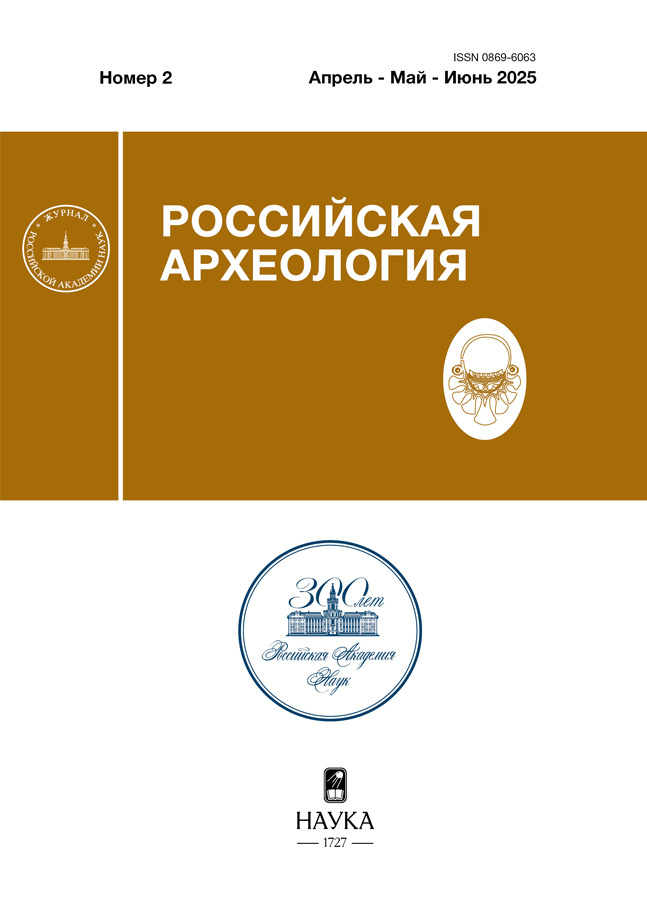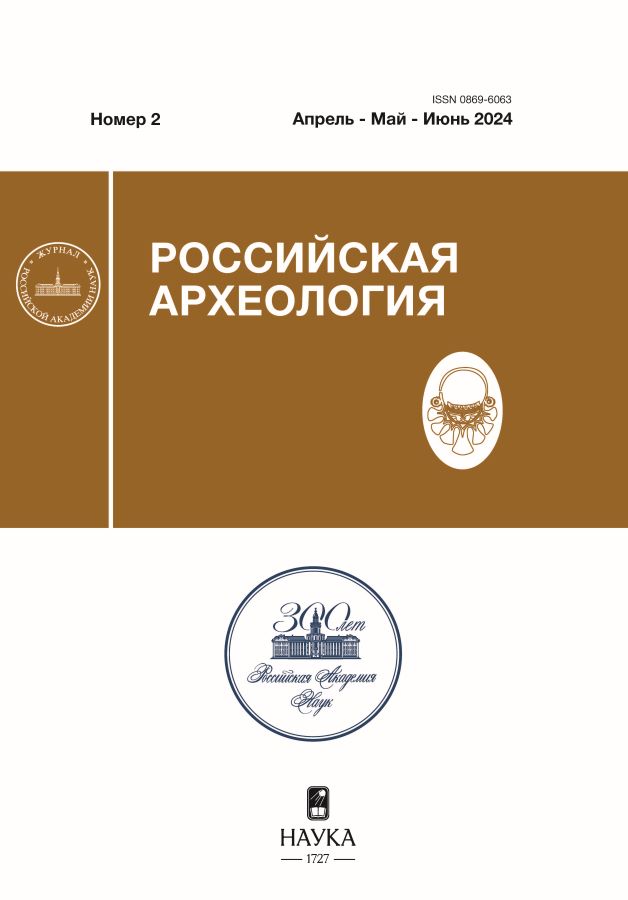Sources of Silver in North-Eastern Rus in the 10th–13th centuries ad according to lead isotope analysis
- Authors: Merkel S.W.1, Zaytseva I.E.2, Chugaev A.V.3
-
Affiliations:
- Amsterdam Free University (Vrije Universiteit)
- Institute of Archaeology RAS
- Institute of Geology of Ore Deposits, Petrography, Mineralogy and Geochemistry RAS
- Issue: No 2 (2024)
- Pages: 81-99
- Section: ARTICLES
- URL: https://ter-arkhiv.ru/0869-6063/article/view/655772
- DOI: https://doi.org/10.31857/S0869606324020063
- EDN: https://elibrary.ru/WOQYAB
- ID: 655772
Cite item
Abstract
The article discusses the results of lead isotope analysis of 54 silver objects from the 9th–13th centuries AD from rural sites of Suzdal Opolye and villages around Murom. As a result of comparing the obtained data with the available databases for Pb-Pb isotopic values of archaeological objects from various collections and ore samples, it was established that in the second half of the 10th – early 11th century AD, Samanid dirhams were used in Opolye as a raw material for jewellery making. In the 11th century, silver from European sources began to flow into the region via the Baltic, becoming dominant by the end of the century. In Opolye and Murom of the 12th century, adornments were made from European raw materials.
Full Text
About the authors
Stephen W. Merkel
Amsterdam Free University (Vrije Universiteit)
Author for correspondence.
Email: swmerkel@hotmail.com
Netherlands, Amsterdam
Irina E. Zaytseva
Institute of Archaeology RAS
Email: izaitseva@yandex.ru
Russian Federation, Moscow
Andrey V. Chugaev
Institute of Geology of Ore Deposits, Petrography, Mineralogy and Geochemistry RAS
Email: vassachav@mail.ru
Russian Federation, Moscow
References
- Adamczyk D., 2020. Monetarisierungsmomente, Kommerzialisierungszonen oder fiskalische Währungslandschaften? Edelmetalle, Silberverteilungsnetzwerke und Gesellschaften in Ostmitteleuropa (800–1200). Wiesbaden: Harrassowitz. 305 p.
- Baker J., Stos S., Wеight T., 2006. Lead isotope Analysis of Archaeological Metals by Multiple-Collector inductively coupled Plasma Mass Spectrometry. Archaeometry, vol. 48, iss. 1, pp. 45–56.
- Baron S., Tămaş C., Cauuet B., Munoz M., 2011. Lead isotope analyses of gold-silver ores from Roşia Montană (Romania): a first step of a metal provenance study of Roman mining activity in Alburnus Maior (Roman Dacia). Journal of Archaeological Science, vol. 38, iss. 5, pp. 1090–1100.
- Chernyshev I.V., Chugaev A.V., Shatagin K.N., 2007. High-precision Pb isotope analysis by multicollector-ICP-mass-spectrometry using 205TI/203TI normalization: optimization and calibration of the method for the studies of Pb isotope variations. Geokhimiya [Geochemistry International], 11, pp. 1155–1168. (In Russ.)
- Chugaev A.V., Chernyshev I.V., Lebedev V.A., Eremina A.V., 2013. Lead isotopic composition and the origin of Quaternary lavas of the Elbrus volcano (Big Caucasus, Russia): data from the high-precision MC-ICP-MS method. Petrologiya [Petrology], vol. 21, no. 1, pp. 20–33. (In Russ.)
- Chugaev A.V., Merkel S.W., Zaytseva I.E., 2020. Lead isotopic characteristics and metal sources for the jewelry in the medieval rural settlements from Suzdal Region (Kievan Rus’). Metalla, vol. 25, no. 2. Bochum, pp. 101–125.
- Chugaev A.V., Zaytseva I.E., 2019. Lead isotopic composition in ornaments from medieval rural settlements of Suzdal Opolye and identification of metal sources. Arkheologiya i istoriya Pskova i Pskovskoy zemli: Ezhegodnik Seminara imeni akademika V.V. Sedova [Archaeology and history of Pskov and the Pskov land: Yearbook of the Academician V.V. Sedov seminar], 34. Materialy 64-go zasedaniya (2018 g.) [Proceedings of the 64th session (2018)]. Moscow; Pskov: Institut arkheologii Rossiyskoy akademii nauk, pp. 348–376. (In Russ.)
- Ciugudean H., 2012. Ancient gold mining in Transylvania: the Roşia Montană-Bucium Area. Caiete ARA, 3, pp. 219–232.
- Eniosova N.V., 2016. Chemical composition of non-ferrous metal from Gnyozdovo. Istoricheskiy zhurnal. Nauchnye issledovaniya [History magazine – Research], 6 (36), pp. 724–733. (In Russ.)
- Eniosova N.V., Mitoyan R.A., 2011. Arab silver as a source of raw materials for Slavic and Scandinavian jewellers (based on materials from the Gnyozdovo hoards of the 10th century AD). Ot paleolita do Srednevekov’ya [From the Palaeolithic to the Middle Ages]. Moscow: Istoricheskiy fakul’tet Moskovskogo gosudarstvennogo universiteta, pp. 90–95. (In Russ.)
- Eniosova N.V., Mitoyan R.A., Saracheva T.G., 2008. Chemical composition of jewellery raw materials of the Middle Ages and the ways of its import to the territory of Rus. Tsvetnye i dragotsennye metally i ikh splavy na territorii Vostochnoy Evropy v epokhu Srednevekov’ya [Non-ferrous and precious metals and their alloys in the territory of Eastern Europe during the Middle Ages]. Moscow: Vostochnaya literatura, pp. 107–162. (In Russ.)
- Eniosova N.V., Mitoyan R.A., Singkh V.K., 2017. New data on the chemical composition of raw materials used by Novgorod jewellers in the 10th–15th centuries AD. Arkheologiya i istoriya Pskova i Pskovskoy zemli. Seminar imeni akademika V.V. Sedova [Archaeology and history of Pskov and the Pskov land. Academician V.V. Sedov Seminar], 32. Materialy 62-go zasedaniya (2016 g.) [Proceedings of the 62nd session (2016)]. Moscow; Pskov: Institut arkheologii Rossiyskoy akademii nauk, pp. 187–203. (In Russ.)
- Eniosova N.V., Saracheva T.G., 2005. “Gold is from Greeks... but silver is from the Czech and Hungarian lands” (Routes of importing jewellery raw materials to the North and South of Rus in the 9th–11th centuries AD). Rus’ v IX–XIV vekakh. Vzaimodeystvie Severa i Yuga [Rus in the 9th–14th centuries AD. Interaction of North and South]. Moscow: Nauka, pp. 11–19. (In Russ.)
- Gale N.H., 1999. Lead isotope characterization of the ore deposits of Cyprus and Sardinia and its application to the discovery of the sources of copper for Late Bronze Age oxhide ingots. Metals in Antiquity. Oxford: Archaeopress, pp. 110–121. (British Archaeological Reports. International Series, 792).
- Gale N.H., Stos-Gale Z.A., Maliotis G., Annetts N., 1997. Lead isotope data from the isotrace laboratory, Oxford: Archaeometry data base 4, ores from Cyprus. Archaeometry, vol. 39, iss. 1, pp. 237–246.
- Al-Ganad I., Lagny P., Lescuyer J.L., Ramboz C., Touray J.C., 1994. Jabali, a Zn-Pb-(Ag) carbonate-hosted deposit associated with Late Jurassic rifting in Yemen. Mineralium Deposita, 29, pp. 44–56.
- Garrood W., 2008. The Byzantine conquest of Cilicia and the Hamdanids of Aleppo, 959–965. Anatolian Studies, 58, pp. 127–140.
- Gaydukov P.G., Oleynikov O.M., 2014. On the sources of raw materials on the Novgorod market of non-ferrous metals in the 15th century AD. Novgorod i Novgorodskaya zemlya [Novgorod and the Novgorod land], 28. Velikiy Novgorod: Novgorodskiy muzey-zapovednik, pp. 263–266. (In Russ.)
- Gomzin A.A., 2023. Kufic coins. Arkheologiya Suzdal’skoy zemli [Archaeology of the Suzdal land], 2. Moscow; Vologda: Drevnosti Severa, pp. 87–102. (In Russ.)
- Grigor’eva N.V., Krupenik V.A., Krupenik Z.V., 2021. Copper of the Volkhov River banks. Arkheologicheskie vesti [Archaeological news], 31. St. Petersburg: Institut istorii material’noy kul’tury Rossiyskoy akademii nauk, pp. 277–285. (In Russ.)
- Hardt M., 2019. The importance of long-distance trade of the Slavic princes in the Early and High Middle Ages. The Medieval Networks in East Central Europe: Commerce, Contacts, Communication. London: Routledge, pp. 174–186.
- Ilisch L., Lorenz S., Stern W.B., Steuer H., 2003. Dirham und Rappenpfennig. Mittelalterliche Münzprägung in Bergbauregionen. Bonn: Habelt. 204 p. (Zeitschrift für Archäologie des Mittelalters; supplement 17).
- Jankowiak M., 2016. Byzantine coins in Viking-Age northern lands. Byzantium and the Viking world. F. Androshchuk, J. Shepard, M. White, eds. Uppsala: Uppsala Universiteit, pp. 117–139. (Studia Byzantina Upsaliensia, 16).
- Kershaw J., Merkel S.W., 2021. Silver recycling in the Viking Age: Theoretical and analytical approaches. Archaeometry, 64, pp. 116–133.
- Kershaw J., Merkel S.W., 2023. International trade in outland resources: the mining and export of lead in early medieval England in light of new isotope data from York. Medieval Archaeology, vol. 67, iss. 2, pp. 249–282.
- Kirpichnikov A.N., Eniosova N.V., 2004. Casting moulds for producing ingots from Staraya Ladoga. Vostochnaya Evropa v Srednevekov’e: k 80-letiyu Valentina Vasil’evicha Sedova [Eastern Europe in the Middle Ages: to the 80th anniversary of Valentin Vasilievich Sedov]. Moscow: Nauka, pp. 290–296. (In Russ.)
- Klein S., Rose T., Westner K.J., Hsu Y.-K., 2022. From OXALID to GlobaLID: Introducing a modern and FAIR lead isotope database with an interactive application. Archaeometry, vol. 64, iss. 4, pp. 935–950. doi: 10.1111/arcm.12762.
- Koroleva E.V., 2017. Interpretation of data on the chemical composition of medieval objects: opportunities and risks of an integrated approach. Arkheologiya i istoriya Pskova i Pskovskoy zemli. Seminar imeni akademika V.V. Sedova [Archaeology and history of Pskov and the Pskov land. Academician V.V. Sedov Seminar], 32. Materialy 62-go zasedaniya (2016 g.) [Proceedings of the 62nd session (2016)]. Moscow; Pskov: Institut arkheologii Rossiyskoy akademii nauk, pp. 27–35. (In Russ.)
- Makarov N.A., Shpolyanskiy S.V., Fedorina A.N., 2023. General nature of settling and the dynamics of territory development. Arkheologiya Suzdal’skoy zemli [Archaeology of the Suzdal land], 1. Moscow; Vologda: Drevnosti Severa, pp. 41–68. (In Russ.)
- Merkel S., 2022. The elemental and lead isotope analysis of brass and other copper-based alloys from Viking Hedeby and High Medieval Schleswig. Haithabu 983–1066. Der Untergang eines dänischen Handelszentrums in der späten Wikingerzeit. München: Verlag Dr. Friedrich Pfeil, pp. 423–456. (Die Ausgrabungen in Haithabu, 19).
- Merkel S.W. Early to high medieval lead, pewter and tin from workshops and trading contexts in West and North Germany: Elemental and lead isotope analysis. (In print).
- Merkel S.W., 2016. Silver and the Silver Economy at Hedeby. Raw Materials, Innovation, Technology of Ancient Cultures. Bochum: Verlag Marie Leidorf. 273 p.
- Merkel S.W., Oravisjärvi J., Kershaw J., 2023. Early Islamic silver: sources revealed through lead isotope analysis of dirhams. Antiquity, vol. 97, iss. 396, pp. 1564–1580.
- Noonan T.S., 2001. Volga Bulgharia’s tenth-century trade. Archivum Eurasiae medii aevi, 11, pp. 140–218.
- Oleynikov O.M., Rudenko K.A., 2017. Finds of copper ladles of 12th century in Veliky Novgorod: the issue of the sources and composition of raw materials in the Novgorod market of non-ferrous metals revisited. Kratkie soobshcheniya Instituta arkheologii [Brief Communications of the Institute of Archaeology], 247. C. 326–341. (In Russ.)
- Pernicka E., 2014. Provenance Determination of Archaeological Metal Objects. Archaeometallurgy in Global Perspective: Methods and Syntheses. Heidelberg: Springer, pp. 239–268.
- Roslund M., 2015. At the end of the silver flow. Islamic dirhams in Sigtuna and the shrinking Viking network. Small Things Wide Horizons: Studies in Honour of Birgitta Hårdh. Oxford: Archaeopress, pp. 43–48.
- Saprykina I.A., Chugaev A.V., Zelentsova O.V., Bakirov B.A., Kichanov S.E., 2023. Study of the chemical and Pb isotope composition in dirhams from the Podbolotyevo cemetery. Nizhnevolzhskiy arkheologicheskiy vestnik [The Lower Volga archaeological bulletin], vol. 22, no. 2, pp. 168–185. (In Russ.)
- Stacy J.S., Doe B.R., Roberts R.J., Delevaux M.H., Gramlicht J.W., 1980. A lead isotope study of mineralization in the Saudi Arabian Shield. Contributions to Mineralogy and Petrology, 74, pp. 175–188.
- Steuer H., Stern W.B., Goldenberg G., 2002. Der Wechsel von der Münzgeld- zur Gewichtsgeldwirschaft in Haithabut um 900 und die Herkunft des Münzsilbers im 9. und 10. Jahrhundert. Haithabu und die frühe Stadtentwicklung im nördlichen Europa. Neumünster: Wachholtz, pp. 133–167.
- Valiulina S.I., Khramchenkova R.Kh., 2001. Chemical composition of non-ferrous metal objects from the Bolshye Tigany burial ground. Drevnie remeslenniki Priural’ya [Ancient artisans of the Urals]. Izhevsk: Udmurtskiy institut istorii, yazyka i literatury Ural’skogo otdeleniya Rossiyskoy akademii nauk, pp. 264–280. (In Russ.)
- Yanin V.L., 2009. Denezhno-vesovye sistemy domongol’skoy Rusi i ocherki istorii denezhnoy sistemy srednevekovogo Novgoroda [Monetary weight systems of pre-Mongol Rus and studies in the history of the medieval Novgorod’s monetary system]. Moscow: Yazyki slavyanskikh kul’tur. 414 p.
- Yener K., Sayre E., Joel E., Ozbal Barnes I., Brill R., 1991. Stable lead isotope studies of Central Taurus оre sources and related artifacts from Eastern Mediterranean Chalcolithic and Bronze Age sites. Journal of Archaeological Science, 18, pp. 541–577.
- Zaytseva I.E., 2015. Belt sets from the Shekshovo cemetery in Suzdal Opolye region. Kratkie soobshcheniya Instituta arkheologii [Brief Communications of the Institute of Archaeology], 236, pp. 161–165. (In Russ.)
- Zaytseva I.E., Saracheva T.G., 2011. Yuvelirnoe delo “Zemli vyatichey” vo vtoroy polovine XI – XIII v. [Jewellery craft of the Land of Vyatichs in the second half of the 11th – 13th century AD]. Moscow: Indrik. 402 p.
Supplementary files



















